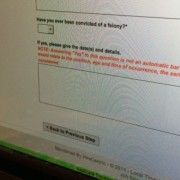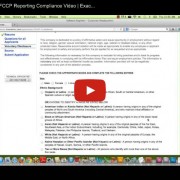What is an Applicant Flow Log? – Whiteboard [VIDEO]
If your growing organization is accepting federal contracts or subcontracts for the first time and you are unsure about compliance regulations that may now be applicable to your business, then this Whiteboard Chat is for you. In this video, Jeff Hallam, explains the purpose of an applicant flow log report, and comments on which organizations must prepare one in order to be compliant with Affirmative Action regulations enforced by the Office of Federal Contract Compliance Programs (OFCCP).
Video Transcript:
Hi today we’re going to talk about what is an applicant flow log. An applicant flow log is a report that’s generated annually, and it’s used by organizations that are required, from an Affirmative Action perspective, to make sure that they are not discriminating against candidates for any illegal reasons. And all of this is subject under the umbrella of Affirmative Action, which applies typically to organizations, either directly through contracts, or indirectly through subcontracts, of certain amounts that are doing business with the federal government. And when you look at what we’re going to talk about today, you’ll notice right away there’s quite an alphabet soup of acronyms that are going to be used when you talk about Affirmative Action.
But we’re trying to simplify this a little bit and understand this isn’t meant to be a full explanation on Affirmative Action, but at least a way to help you make sure that you understand whether your organization might be perhaps subject to this, and if so, what are some key things that you need to be made aware of.
So, some of the players when you talk about an applicant flow log and Affirmative Action…all of this is administered and governed under the auspices of the OFCCP, otherwise known as the Office of Federal Contract Compliance Programs. And this is an offshoot of the Department of Labor, so as you would expect, all of this falls ultimately under the Department of Labor as to whether organizations are being compliant. There are a couple of recent updates that have been passed along with Affirmative Action just as of the last year or so that expanded the pools of applicants through which discrimination has to be tested.
One of those, the Vietnam Era Veterans Readjustment Assistance Act, or VEVRAA, applies to people who have been in the service, making sure that organizations aren’t discriminating against them. Likewise, Section 503 of the Rehabilitation Act applies to organizations, or individuals rather, who may have certain types of disabilities. And again, making sure that those folks aren’t being discriminated against. So when you look at an applicant flow log, understanding some of these basics in simplest terms, these items in this box here are what an applicant flow log is designed to track during the course of a year. So they’re very specific requirements that from an Affirmative Action perspective must be met to make sure that, again that discrimination isn’t taking place.
So what an applicant flow log will track per job are these items here…so the name of each candidate, the date that they applied, their race, their gender, veteran status, disability status and then disposition. And there could be a couple of other things here and there that your administrator may request, but these are typically the core things that have to be there for any applicant flow log report. And when you talk about disposition sometimes that can be a little confusing to people. What disposition really looks at is what did we do with a candidate? And there are, again, some key components to that. So when we say what did we do with them, meaning what ultimately did we decide to do from a hiring perspective. Did we hire them? If not, why not? When did we make that determination? And then who was it within the organization who made that determination?
So there have to be very specific things that are tracked along the way so that when it comes time to provide this applicant flow log report for your Affirmative Action purposes, all of these given data elements are there. So, as to tracking these elements, there are a couple of core ways that most organizations may do this. So if you work with job boards, or you accept email resumes, then typically you are going to have to find a mechanism usually in the form of an online document, or something that you’re going to have to email candidates, that allows them to voluntarily provide this information because it does have to be requested of each candidate. They have the option as to whether they want to disclose any of this information, but you have to have a record of the fact that you made it available to them.
Likewise, the other option, where more organizations seem to be headed is, if they are using an applicant tracking tool that will automate much of this, that can simplify things dramatically. Now, as candidates apply or indicate interest in the job, that information is offered to them right up front, it can be escrowed and held separately from the rest of the application, so that when it does come time to produce this applicant flow log information at the end of the year, that information is already there, readily available, and can be reported on at a moment’s notice.
So, again, that is just a very quick update on what an applicant flow log is. If you do have questions about whether your organization is subject to Affirmative Action reporting, or whether you have to worry about an applicant flow log yourself, typically we would suggest that you check with a qualified labor and employment law attorney, so that they can review your particular business practices.









